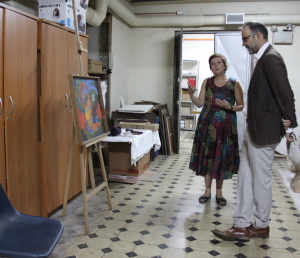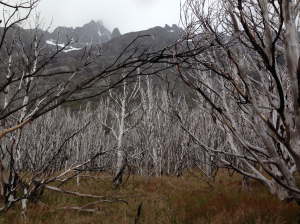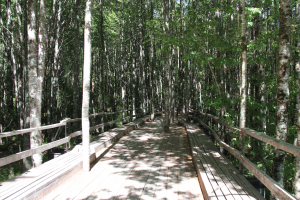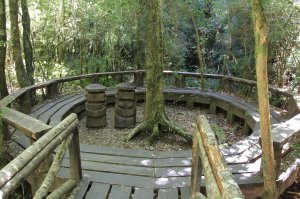I had the incredible luck of getting to travel through Chile with my partner last month. We spent some time in Santiago, then took a road trip to the south, then flying very south, all the way to the Strait of Magellan. We hiked ‘The W’ in Torres Del Paine:
walked through the remnants of a forest fire:
rode horses with gauchos:

drank straight out of streams, swam in glacial water…
(Click on any of these images to see them larger.)
It was our personal Savage Detectives, because we on the trail of the last remaining living connections to Alex’s grandmother, Mireya Lafuente who was a famous painter in her day. We met her student, the writer Virginia Vidal, we saw Mireya’s paintings in various museums (here’s Bellas Artes in Santiago)

and we found the exact corner she set her easel on in Valparaíso.
There are heaps of inspirations I could write about: earth architecture in Santiago, the beauty of an entire countryside free from fast food chains (how tragically different American small towns are nowadays), or in a sort of hilarious way, the incredible number of clashing prints and patterns worn by the general populace (gone are the days of dreary black/grey/brown anonymity that Virginia described with a tremor, referring to the 70’s and 80’s).
One of the stranger and more thought-provoking experiences was our visit to the Huilo Huilo Reserva Natural Biosfera in the Lake District. We should have known that something was up when the Lonely Planet Guide described it as being ‘Frodo approved’. Indeed. One of the world’s first private nature reserves, it’s an interesting case study for ways of preserving the natural world without governmental aid. This poses a wealth of strange architectural and design issues. It was natural, sure, and a reserve of sorts, but their design ended up making it look more like a Disneyland than anything else.
Raised walkways were built to reduce damage on the forest floor, but it was hard to imagine that installing the posts and tiny holes around tree trunks didn’t have other damaging side effects.
The hotels were shaped like magic mountains, or in forms inspired by fungi, and strangely disguised by trees and waterfalls (they import the lumber from a nearby tree farm). But the rhizome-inspired interiors were more like labyrinths shooting you out mysteriously in the same spot over and over.
The most suspect were the huge carved tree trunks that were designed after local Mapuche Indian carvings. Yes it brings attention to the local tribe, but the Reserve’s actual relationship to the people… unknown.
Still, it’s an pressing issue: how to design natural tourism that doesn’t destroy the natural beauty. Either Frodo, or his business advisor… someone’s got to manage it.






Recent Comments